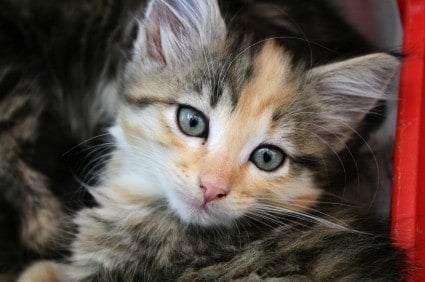Hormone Disorders in Cats
The hormone or endocrine system is made up of seven glands that produce substances called hormones, which travel to different parts of the body and stimulate a response. Disorders occur when the glands produce either too much or too little of a particular hormone. The most common hormonal disorders in cats are diabetes mellitus, where an abnormal response to the hormone insulin causes excessively high blood and urine sugar and hyperthyroidism, which results from excess thyroid hormone levels in older teenage cats.
CAUSES
1. Diabetes Mellitus is defined as a “dysfunction” in the amount, availability, and/or biological activity of insulin, which is secreted by the pancreas. This results in excess blood sugar levels and many other disorders.
2. The exact cause is not known but obesity, genetics and pancreatic disease may be predisposing factors.
3. Male Siamese cats are most prone.
4. The underlying cause of Thyroid Disease is often unknown. In some cats, Cancer is responsible. Secondary Heart and Kidney Disease often result but may resolve once the thyroid problem is controlled.
5. Hypothyroidism causes obesity. Cats gain weight without an increase in appetite and often have a dry, flaky haircoat and are lethargic. This occurs occasionally in cats.
HYPERTHYROIDISM SYMPTOMS
Hyperthyroidism is very common in old cats. Chronic weight loss despite a voracious appetite is the hallmark sign. Older teenage cats are very thin, often vomit, and have poor, unkempt scruffy hair coats.
DIABETES: SYMPTOMS
Excessive urination, drinking and increased appetite along with weight loss are the most common initial signs. Cats remain alert and active then later develop recurring infections which often involve the urinary tract and/or skin. Diabetic Neuropathy can occur because of nerve damage. Lack of blood supply to nerves of the hind legs causes cats to stand on their hocks, a “plantigrade stance” instead of on their toes.
HYPOTHYROIDISM SYMPTOMS
Obesity and weight gain without an increase in appetite, dry, flaky skin and hair coats and lethargy occur. This is uncommon in cats.
WHAT YOU AND YOUR VET CAN DO
* Diagnosis of diabetes is based on signs as well as blood and urine tests that show elevated sugar levels. There is no cure; insulin replacement is an effective control. Insulin requirements can change and must be monitored daily for life. Too much or too little insulin can cause life- threatening seizures. Some cats revert back to a normal non-diabetic state and need no further therapy or insulin with weight reduction and stabilization of blood sugar levels.
* Most cats are treated with insulin injections given daily under the skin. Controlling diet and exercise along with neutering helps keep insulin requirements consistent.
* A variety of oral medications that decreases blood sugar are available. Most are relatively safe and effective in diabetic cats that are otherwise healthy. Concurrent liver and kidney problems must be considered.
* Obese cats must lose weight gradually, losing no more than one percent of their body weight weekly. High fiber (10-15%) low fat diets work best. Omega-3 Fatty Acids should not be added to the diets of diabetic cats because they will increase the blood sugar.
* Hyperthyroidism is diagnosed with a blood test, which detects increased levels of thyroid hormone. Most cases are not curable but can be controlled. Therapy varies with the underlying cause of Thyroid Disease, the cat’s age, and whether other medical problems like heart or kidney disease exist.
HYPERTHYROIDISM TREATMENT OPTIONS
Hyperthyroidism treatment options include:
1. Tapazole (generic Methimazole) is an oral tablet given daily are the cheapest, most effective solution for many cats.
2. Radiotherapy consists of using Radioactive Iodine injections that destroy abnormal thyroid tissue. Many consider this to be the best therapy. It is very costly.
3. Surgical Removal of the diseased thyroid is difficult surgery, dangerous in old cats and not necessarily effective. Tapazole may still be needed.
COMPLEMENTARY THERAPY: DIABETES
Diabetes Therapy is geared to lower and stabilize blood sugar and increase the body’s sensitivity to insulin. Many commercial foods are specifically formulated for Diabetes in cats i.e. Hills W/D (DM Purina (CMN).
Vanadium and Chromium are minerals naturally found in broccoli, white potatoes and tomatoes. They increase sensitivity to insulin, which promotes stabilization of blood sugar levels.
* Vanadium, a mineral, helps to stabilize blood sugar. Broccoli and tomatoes are a source.
* Coenzyme Q10 – 10 milligrams three times daily.
* Vitamin C powder – 250 milligrams three times daily.
* Vitamin E – 400 IU once a week – open capsule, mix in meal.
* Pancreatic Glandulars – a source of pancreatic cells therefore potentially a source of insulin. Sold at organic markets. Safe and tastes good.
* Increase Dietary Fiber – sources include: one teaspoon chopped alfalfa sprouts, one half teaspoon oat bran, one teaspoon grated raw zucchini or carrots or one teaspoon cooked green beans or squash.
fungus and are toxic to the liver and can’t use in pregnant cats.
